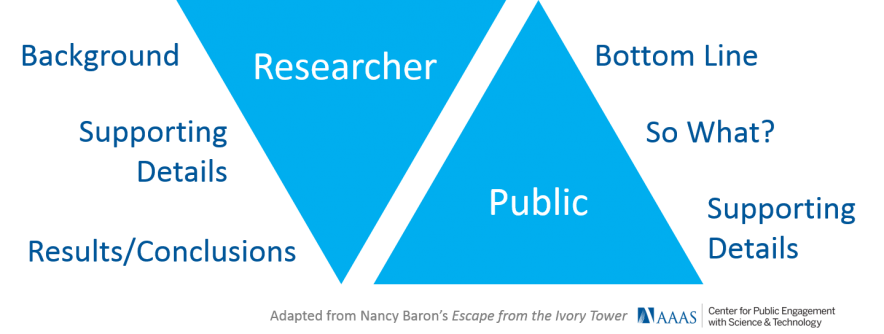Make it relevant
- Give the reader a reason to care about what you do. Focus on the relevance and/or the application of your research for patients/clinicians/etc. Why is your work important to them? What are the benefits? Address their “so what?” questions.
- The text should provide answers to the essential questions: Who, What, Where, When, Why and How?
- Provide context. Give concrete everyday examples. Paint a picture for the reader.
- The language used should be person centered rather than focusing on the circumstance, illness or disability. For example “people with cancer” is preferable to “cancer sufferers;” a person “has cancer” rather than “is a victim of cancer.”
Structure and grammar
- Most journal submissions include a lengthy background, then describes the methods and process used with great precision, and reports the results and conclusion at the very end. Your plain English summary should be the opposite. The bottom line should be your first sentence, followed by the “so what?” and then brief supporting details.
- The text should be ordered logically and flow naturally. New ideas should not be introduced late in the text.
- Write in active voice – not passive voice.
- Grammar and punctuation should be accurate and spelling should follow appropriate conventions.
- Respect the length requirements for the lay summary. ISOQOL suggests between 100 and 200 words.
This image was originally used by the American Association for the Advancement of Science as part of their Communication Toolkit.
Keep it simple
- Try to explain your research in 25 words or less. Use this as your first sentence.
- Use short, clear sentences (25 words or less). Avoid complex grammatical structures.
- Minimize the use of jargon, scientific or technical terms and acronyms. If this is unavoidable, provide short explanations.
- Use simple words and cut out unnecessary words. Here are examples of words and phrases that can be simplified:
- Participate in – take part
- Prior to – before
- Discontinue – stop
- In the event of – if
- Duration – time
- Inform – tell
- Scheduled to undergo – due to have
- Accordingly, consequently – so
- With reference to, with regard to – about
- If this is the case – if so
- For the purpose of – to
- Above all, avoid complex terms and phrases. Use plain English.
Examples of scientific terms that should be simplified
This is not an exhaustive list. These are only some of the commonly used terms in health related quality of life research. Always have someone from outside your field review your plain English summary for terms they do not immediately understand.
- Patient-reported Outcomes (PROs): a way to collect information about a patient’s condition directly from the patient
- Patient-reported Outcome Measurements (PROMs): a way to measure information provided directly by the patient
- Patient-centered Outcomes (PCOs): results from treatment that patients care about (survival, symptoms, function, health related quality of life)
- Function: a general term describing a person’s ability to perform any activity or normal body process
- Outcome: an aspect of a person’s health expected to change via treatment
- Adaptive testing: a type of test (often a questionnaire) where the next item (or question) depends on your previous response
GET FEEDBACK!
Find someone who is not in your field to read over the summary. You can get feedback on your draft from colleagues, supervisors, and friends, but make sure at least one person is a non-specialist to your field.

The International Society for Quality of Life Research (ISOQOL) is a global community of researchers, clinicians, health care professionals, industry professionals, consultants, and patient research partners advancing health related quality of life research (HRQL).
Together, we are creating a future in which patient perspective is integral to health research, care and policy.

